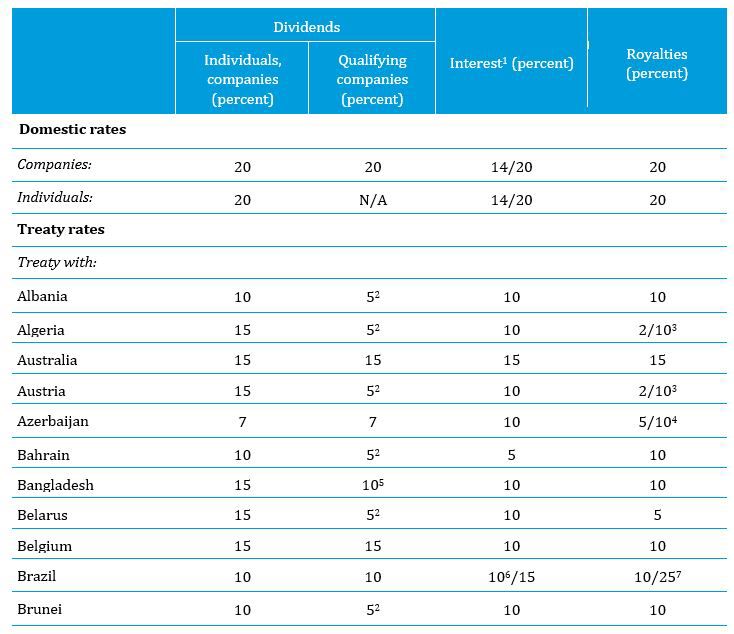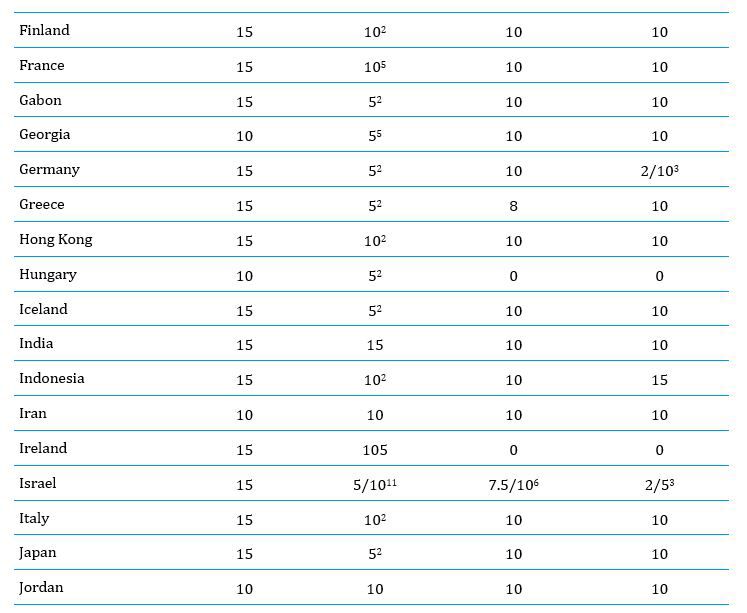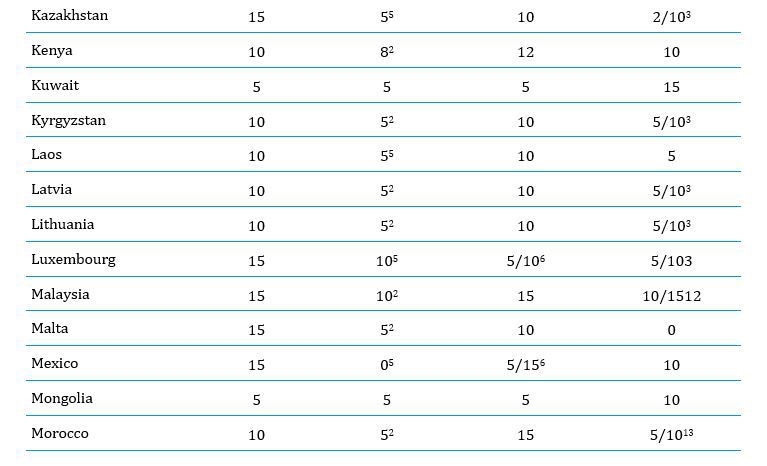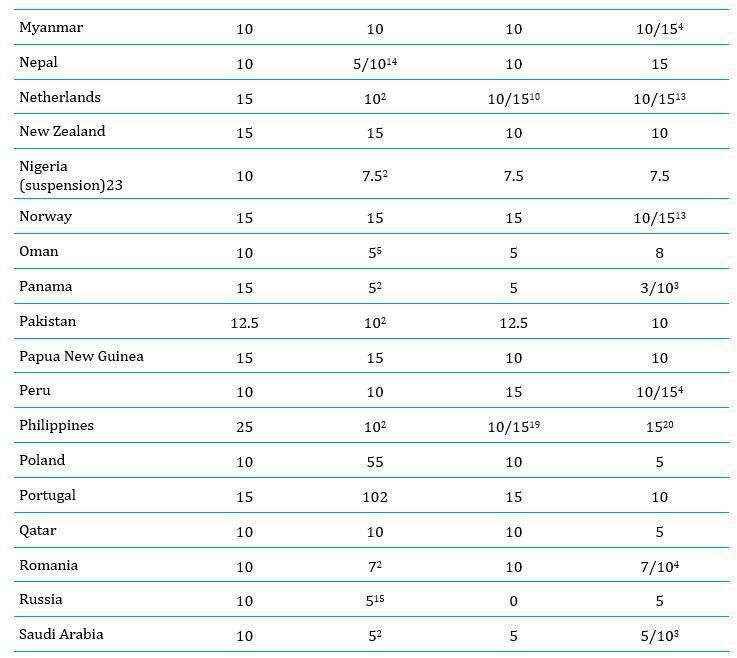Korea - Taxation of cross-border mergers and acquisitions
Taxation of cross-border mergers and acquisitions for Korea.
Taxation of cross-border mergers and acquisitions for Korea.
Introduction
Opportunities for mergers and acquisitions (M&A) in the Republic of Korea (Korea) have increased in recent years. A growing number of companies are turning their attention to M&A to compete in the global economy, expand operations and gain synergistic benefits. As the number of M&A deals in Korea grows, the Korean government continues to provide tax and other benefits to encourage them. Regarding the taxation of cross-border M&A, this report focuses on the following issues:
- asset purchase or share purchase
- choice of acquisition vehicle
- choice of acquisition funding.
Tax is only one part of transaction structuring. The Korean Commercial Law governs the legal form of a transaction, and accounting issues are also highly relevant when selecting the optimal structure.
Investors who are planning cross-border M&A should consider these other matters as well.
Recent developments
Multilateral Convention to Implement Tax Treaty-related Measures to Prevent Base Erosion
and Profit Shifting
On 20 December 2019, the Multilateral Convention to Implement Tax Treaty-related Measures to Prevent Base Erosion and Profit Shifting (MLI) was ratified by the National Assembly of Korea. The MLI was deposited with the Organisation for Economic Co-operation and Development (OECD) on13 May 2020. Korea submitted the list of 73 tax treaties entered into between Korea and other jurisdictions that Korea would like to designate as Covered Tax Agreements (i.e. tax treaties to be amended through the MLI). On the 1st of the following month after 3 months had passed since the deposit date (i.e. on 1 September 2020), the MLI became effective, and the tax treaties with countries that had signed bilateral tax treaties with Korea were modified.
Through this MLI, Korea first applied provisions that fall under the minimum standards under the OECD Action Plans, for example, Article 6 — Purpose of Covered Tax Agreement, Article 7 — Prevention of Treaty Abuse, which includes Principal Purpose Test (PPT), Article 16 — Mutual Agreement Procedure and Article 17 — Corresponding Adjustment.
Extension of tax NOL and tax credit carry-forward period
The tax net operating loss (NOL) carry-forward period is extended from 10 years to 15 years for the NOL incurred from fiscal year commencing on or after 1 January 2020. In addition, the tax credit carry-forward period is also extended from 5 years to 10 years for the tax credit from 1 January 2021.
Asset purchase or share purchase
Investors may purchase a company by way of an asset purchase or a share purchase. Each method has its own tax advantages and disadvantages.
Purchase of assets
Under Korean tax laws, there are two main types of asset purchases — individual asset transfers and comprehensive business transfers. Where, at the discretion of the seller/buyer, only selected assets or liabilities are transferred, the transfer is classified as an individual asset transfer. By contrast, where substantially all the business-related rights, assets, liabilities and employees of a company or a division of a company are transferred, such that the nature and continuity of the business are sustained after the transfer, the transaction is deemed to be a comprehensive business transfer for Korean tax purposes.
Purchase price
Assets and liabilities are valued in the course of an asset purchase, which may result in a capital gains tax liability for the seller and affect the depreciable amount for the buyer. Where a comprehensive business is purchased at its fair market value, the acquisition cost of the target business’s assets may be stepped-up (or down) to their fair market value. In this case, the buyer needs to apportion the total consideration to the assets acquired.
Goodwill
Goodwill is the excess amount of the consideration paid over the fair value of the net assets transferred. For tax purposes, goodwill can only be recognized if it is traceable to a valuable intangible asset and if an appropriate method has been used to calculate the goodwill. Goodwill can be amortized on a straight-line basis over a period of 5 years or more within the tax limit to the extent that an impairment loss under IFRS the amortization expenses are recognized for accounting purposes.
Depreciation
The depreciation cost of the assets recognized in the accounts is deductible for tax purposes within the tax limit, provided it is calculated based on the depreciation method and useful life stipulated for each type of asset under the corporate income tax law. Taxpayers typically choose the straight-line method, declining-balance method or unit of production method to depreciate assets.
Tax attributes
Tax losses and historical tax liabilities are not transferred with the assets in an asset acquisition. On an individual asset transfer, the buyer does not incur a secondary tax liability for any unpaid tax or tax liabilities of the seller that relate to the transferred assets on the official transfer date. However, in a comprehensive business transfer, the buyer assumes a secondary tax liability on any already fixed and determinable tax liabilities of the seller on the official transfer date, in the case where the seller and buyer are the related parties or where the buyer purchases the business for tax avoidance purposes of the seller.
Value-added tax
Value-added tax (VAT) implications arising on an asset transfer depend on whether the transfer is classified as an ‘individual asset transfer’ or ‘comprehensive business transfer’ under Korean tax law. On an individual asset transfer, the seller should withhold VAT at 10 percent from the buyer and remit the collected VAT to the relevant tax authority. A comprehensive business transfer is exempt from VAT.
Transfer taxes
Stamp duty
Stamp duty is levied on the transfer of certain assets listed in the stamp duty law. The rate of stamp duty varies according to the asset acquired. Transfers of real estate are subject to stamp duty ranging from 20,000 to 350,000 Korean won (KRW), depending on the acquisition price.
Acquisition tax
Under the Korean Local Tax Law, a company acquiring land, buildings, vehicles or certain memberships (e.g. golf memberships, condominium memberships and/or sports complex memberships) is liable for acquisition tax, based on the transfer price, type and location of such taxable assets. In certain cases, the applicable acquisition tax rate is higher than the normal rate.
Purchase of shares
Under Korean tax law, the following tax implications may arise on the transfer of shares.
Tax indemnities and warranties
In a share transfer, the buyer takes over all assets and related liabilities together with contingent assets and liabilities. Therefore, the buyer normally requires more extensive indemnities and warranties than in the case of an asset transfer.
Tax losses
In principle, on a change of ownership, the tax losses of a Korean company transfer along with the company.
Crystallization of tax charges
Since the purchase in a share transfer should assume the historical tax liability of the target company for the previous periods within the statute of limitations in Korea, it is usual for the buyer to obtain an appropriate indemnity from the seller.
Transfer taxes
Security transaction tax
A securities transaction tax (STT) is imposed on the transfer of stock of a corporation established under the Commercial Code or any special act, or on the transfer of an interest in a Yuhan Hoesa, Hapmyong Hoesa or Hapja Hoesa established under the Commercial Code. The securities settlement corporation and securities companies are required to collect tax at the time of a transaction. The tax is computed by multiplying the tax base by the tax rate (0.1 percent, 0.23 percent or 0.43 percent, including relevant surtax). For related-party transactions, where the transfer price is lower than the fair market value, the fair market value is used as the tax basis for calculating STT.
Deemed acquisition tax
On a share transfer, no acquisition tax is generally levied. An exception applies where the invested company has certain underlying assets (e.g. land, buildings, structures, vehicles, certain equipment, various memberships) that are subject to acquisition tax specifically defined under the relevant law. Where the investor and its affiliates collectively acquire in aggregate more than 50 percent of the shares in the target company, they are deemed to have indirectly acquired those taxable properties through the share acquisition and become subject to deemed acquisition tax.
Tax clearances
It is possible to obtain a tax clearance certificate from the Korean tax authority to confirm whether there are outstanding tax liabilities as of the tax clearance certificate issuance date.
Choice of acquisition vehicle
Several acquisition vehicles are available to a foreign investor. The tax burden may differ according to the type of acquisition vehicle.
Local holding company
A local holding company may be used as a vehicle for the acquisition of a local company. In this case, by borrowings, the local company can deduct the interest expense against its taxable income within the limits prescribed by Korean tax law. Where the debt is borrowed from a related foreign shareholder, the interest rate should be set at an arm’s length rate equal to the market rate.
The general types of the business entity include the following (among others).
Chusik Hoesa
The Chusik Hoesa is the business organization permitted to issue shares to the public, so it is the most common form of business entity in Korea.
Yuhan Hoesa
A Yuhan Hoesa is organized by one or more partners who have signed on its articles of incorporation (AoI) for their participation with limited liability. One advantage of a Yuhan Hoesa is that it may be possible to obtain flow-through tax treatment for US tax purposes. A Yuhan Hoesa is eligible to make a check-the-box election under US tax law.
Hapmyong Hoesa
A Hapmyong Hoesa is organized by two or more partners who bear unlimited liability for the obligations of the partnership.
A Hapmyong Hoesa is a separate entity subject to corporate income tax.
Yuhan-chekim Hoesa
A Yuhan-chekim Hoesa (limited liability company) has characteristics of both a Yuhan Hoesa and a Hapmyong Hoesa. However, the investors must separately designate employees who will operate the business on the AoI. A Yuhan-chekim Hoesa is a separate entity and subject to corporate income tax.
Hapja Hoesa
A Hapja Hoesa consists of one or more partners having unlimited liability and one or more partners having limited liability. Similar to a Hapmyong Hoesa, a Hapja Hoesa is a separate entity subject to corporate income tax.
Foreign parent company
The foreign investor may directly make a domestic acquisition. Under Korean tax law, dividend and interest payments to a foreign company that does not maintain a permanent establishment in Korea are subject to withholding tax (WHT). Where the foreign resident country of the investor has a tax treaty with Korea, the WHT may be reduced.
Non-resident intermediate holding company
Capital gains on the disposal of shares in a Korean company by a foreign shareholder company are generally subject to Korean tax, except for certain cases.
Dividends and interest payments made to a foreign company are also generally subject to tax. Since a foreign shareholder residing in a foreign jurisdiction that has a tax treaty with Korea may enjoy the tax treaty benefits, establishing an intermediate holding company in a jurisdiction that has a favorable tax treaty with Korea may be considered. However, to be eligible for tax treaty benefits, the intermediate holding company should meet the anti-treaty-shopping provisions (i.e. beneficial owner of the income) under the Korean tax law and the relevant tax treaty.
Joint venture
In most industries, foreign investors may invest without any ownership restrictions. For certain industries, such as newspapers, telecommunications and broadcasters, the Korean government encourages foreign investors to establish joint venture companies with Korean partners rather than wholly owned subsidiaries. In these industries, the government restricts the amount of foreign ownership to a designated percentage.
Choice of acquisition funding
Debt
The investor can use debt and/or equity to fund its investment. Dividend payments are not tax-deductible, but interest expenses can be deducted from taxable income. Expenses incurred in the course of borrowing, such as guarantee fees and bank fees, can also be deducted for tax purposes. Therefore, the investor often prefers to use debt.
Deductibility of interest
In general, interest expenses incurred in connection with a trade or business are deductible for Korean corporate tax purposes. However, certain interest expenses are not deductible, including (among others):
- interest on debt incurred specifically for use in construction projects or for the purchase of fixed assets
- interest on private loans where the source is unknown
- interest payments to unidentifiable recipients
- interest on debt used for the purchase of non-business-related assets
- interest on hybrid instruments, treated as debt in Korea and as equity in the recipient’s resident country, in cases where the recipient’s resident country does not levy domestic tax for the relevant interest income, effective for fiscal years starting on or after 1 January 2018 (the non-deductible amount of interest is a permanent tax adjustment)
- interest paid to the foreign controlling shareholder that exceeds the lower of the two limits under the thin capitalization rules described below:
- Thin capitalization rules
Under Korea’s thin capitalization rules, where a Korean company borrows from its foreign controlling shareholder an amount exceeding two times the equity from the foreign controlling shareholder (six times the equity for financial institutions), interest on the excess portion is not tax-deductible. Money borrowed from a foreign controlling shareholder includes amounts borrowed from an unrelated third party based on guarantees provided by a foreign controlling shareholder. The non-deductible amount of interest is treated as a deemed dividend or other outflow of income, and WHT may apply. - 30 percent of adjusted tax EBITDA
In addition to the above threshold, where a domestic company has a transaction with a foreign-related party, the domestic company may not be able to deduct the net interest expense exceeding 30 percent of the adjusted tax EBITDA (i.e. taxable income + depreciation expense for fixed assets and net interest expense). (The non-deductible amount of interest is treated as other outflow of income.)
- Thin capitalization rules
Withholding tax on debt and methods to reduce or eliminate it
Where a Korean company pays interest to its foreign lender, the payment is subject to Korean WHT at a rate of 22 percent (15.4 percent for interest on bonds), inclusive of local surtax. This WHT could be reduced where the recipient is a foreign lender resident in a jurisdiction that has an applicable tax treaty with Korea. Other interest payments to foreign lenders may be exempt from WHT where certain conditions are met.
Checklist for debt funding
- Consider whether the use of debt may trigger disallowed interest deductions under the relevant limitation rules and whether the interest rate is an arm’s length rate, as required by transfer pricing rules.
- WHT of 22 percent, inclusive of local surtax, applies on interest payments made to a foreign lender that does not have a Korean permanent establishment unless a lower WHT rate is available under the relevant tax treaty.
Equity
An investor may use equity to fund its acquisition.
When capital is injected into a Korean company by an investor, a registration license tax is imposed at a base rate of 0.48 percent (including local surtax) of the par value of the shares issued on incorporation and of the par value of the shares issued in subsequent capital increases. In certain cases, the applicable capital registration tax rate is three times the normal rate.
Dividends paid to a foreign shareholder that is not considered to have permanent establishment in Korea are not tax-deductible and are subject to WHT at the rate of 22 percent, in the absence of a relevant tax treaty. The actual rate depends on the applicable tax treaty.
Merger
Mergers are allowed in Korea between Korean domestic companies. Usually, a merger may result in various tax implications for the parties involved (i.e. dissolving company, shareholders of the dissolving company or the surviving company). However, where the merger is carefully planned and executed, a substantial part of the merger-related taxes may be mitigated or deferred, especially where the merger is considered to be a ‘qualified merger’.
A merger satisfying the following (including but not limited to) basic conditions is generally considered a qualified merger for Korean tax purposes.
- Both companies (i.e. surviving and dissolving companies) have engaged in business for at least 1 year as of the merger date.
- Where consideration is paid, at least 80 percent of the consideration paid to the shareholder of the dissolving company consists solely of shares in the surviving company.
- The surviving company continues to carry out the operations of the transferred business until the end of the fiscal year of the merger.
- The number of the employees of the dissolving company transferred upon merger should exceed 80 percent of the number of total employees of the dissolving company as of 1 month before the merger registration date, and such percentage should be maintained until the end of the fiscal year when the merger takes place.
In the case of a merger, tax loss carry forwards of the surviving company can only be used to offset profits generated from the original business of the surviving company. Similarly, the tax loss carry forwards of the dissolved company can only be used to offset the profits from the business of the dissolved company.
Hybrids
Hybrid instruments are classified either as debt or equity for tax purposes depending on their legal form, rather than their economic substance. Thus, in principle, hybrid instruments, such as profit-sharing loans and interest-free loans, are classified as debt for tax purposes, while redeemable preference shares are classified as equity.
Discounted securities
Securities can be issued at a discount when the nominal interest rate is below the market interest rate. The difference between the nominal price and the issue price may be deducted over the life of the security. However, where the lender is a related party, the interest rate should be based on an arm’s length rate to avoid any transfer pricing tax adjustments.
Deferred settlement
Not applicable.
Other considerations
Company law and accounting
The Commercial Law prescribes conditions and procedures related to establishing and liquidating an entity and to M&A- type transactions, such as mergers, split-offs and spin-offs. Where the company fails to comply with the legal and other procedures necessary for such a transaction, the applicable contracts may be considered invalid.
Group relief/consolidation
Group relief/consolidation is available where the controlling company holds 100 percent of the outstanding shares of the subsidiary company and the subsidiary company’s head office is located in Korea.
The tax rates for the consolidated group are the same as the corporate income tax rates. Consolidated tax returns must be submitted to the competent tax authority within 4 months of the end of each fiscal year.
Transfer pricing
Under Korean tax law, where the transfer price used between a Korean company and its foreign-related party is below or above the arm’s length price, the tax authority has the ability to adjust the transfer price and recalculate the resident’s taxable income.
The arm’s length price should be determined by the most reasonable method in the situation. The taxpayer should disclose the method and reason for adopting it to the tax authorities in a report submitted with the annual tax return.
Dual residency
Not applicable.
Foreign investments of a local target company
Anti-tax haven rules apply where a Korean resident company or individual has invested in a controlled foreign company (CFC) that is located in a tax haven country and has unreasonably retained profits under that country’s local generally accepted accounting principles as they pertain to the Korean resident. Where these rules apply, the retained profits are treated as dividends paid to the Korean resident, even where the reserved profits were not actually distributed.
Where a Korean resident individual or company, directly or indirectly, owns at least 10 percent of the voting shares in the foreign-related company, the Korean resident individual or company is subject to the anti-tax haven rules.
These rules are intended to regulate a Korean company that has made abnormal investments in a foreign company that has an average effective income tax rate of 15 percent or less (for both local and foreign income taxes) for the 3 most recent consecutive years.
However, where a company incorporated in a tax haven country actively engages in business operations through an office, shop or factory that is required for those operations, the anti-tax haven rules do not apply as long as the company has not been engaged in certain listed businesses.
Additionally, the above threshold applies only to business years in which a CFC has engaged in those businesses. Thus, the anti-tax haven rules would apply to fiscal years in which the CFC conducted business mainly in:
- wholesale, financial service and insurance, real estate and leasing, professional/scientific and technical services (excluding architectural, engineering and other related services), and business support services, or
- earning passive income arising from owning shares or bonds, providing intellectual rights, renting vessels, aircrafts or equipment, or investment in trust or fund.
If the CFC is a holding company whose main business is to hold and own stocks, the anti-tax haven rules do not apply if the CFC holds at least 40 percent of the shares of its subsidiaries in the same jurisdiction for more than 6 months and 90 percent or more of the CFC’s income consists of interest and dividends from subsidiaries in the same jurisdiction.
Comparison of asset and share purchases
Advantages of asset purchases
- The purchase price can be depreciated (amortized) for tax purposes.
- Historical liabilities of the company are not transferred to the new or surviving company.
- No transfer of retained earnings and possible tax liabilities.
- Possible to acquire only part of a business.
Disadvantages of asset purchases
- Benefit of any tax losses incurred by the target company remains with the seller.
- Buyer may be subject to acquisition tax on purchasing applicable assets.
Advantages of share purchases
- Buyer may benefit from tax losses of the target company.
- Buyer may gain the benefit of existing supply or technology contracts.
Disadvantages of share purchases
- Buyer bears secondary tax liability of a target company as a majority shareholder.
- No deduction is available for the purchase price until the disposal of the shares.
- Seller is subject to securities transaction tax.
Korea — Withholding tax rates
This table is based on information available as of 31 December 2019.
The following table contains the WHT rates that are applicable to dividend, interest and royalty payments from Korea to non-residents under the tax treaties currently in effect. Where, in a particular case, a rate is higher than the domestic rate, the latter is applicable. If the treaty provides for a rate lower than the domestic rate, the reduced treaty rate may be applied at source if the appropriate residence certificate has been presented to the withholding agent making the payment.
However, a withholding agent should obtain pre-clearance from the tax office before applying a treaty to a resident of a country or a region designated by the Ministry of Strategy and Finance (Labuan, Malaysia is currently designated as such). Without the pre-clearance, the withholding agent should apply the domestic WHT tax rates.
An income recipient that claims a reduced tax rate under a tax treaty should submit an application to the income payer before the income is paid.
To identify the exact withholding taxes and calculate the total tax cost of your cross-border transaction, further review should be required.
Source: National Tax Service, Republic of Korea, 2020







Notes
- Many of the treaties provide for an exemption or a reduced rate for certain types of interest, for example, interest paid to public bodies and institutions, banks or financial institutions, or in relation to sales on credit or approved loans. Such exemptions or reductions are not considered in this column.
- The rate generally applies with respect to participations of at least 25 percent of capital or voting shares/power, as the case may be. In the treaty with Japan, there is a minimum shareholding period of 6 months immediately before the end of the accounting period for which the distribution takes place. In the treaty with Colombia, Pakistan, Ukraine and Uruguay, the lower rates apply if the beneficial owner is a company other than a partnership that holds directly at least 20 percent of the capital of the company paying the dividends.
- The lower rate applies to royalties for the use of, or the right to use, industrial, commercial or scientific equipment (and information concerning industrial, commercial or scientific experience in the treaty with Luxembourg and Kazakhstan). The protocol to the treaty with Chile includes a most-favored-nation clause, whereby if Chile concludes an agreement with a third OECD member state with a reduced rate, the reduced rate will automatically apply under this tax treaty.
- The lower rate applies to payments for the use of, or right to use, a patent, trademark, design or model, plan, secret formula or process, or industrial, commercial, and scientific equipment or information. In the tax treaty with Peru, the lower rates apply for the payments received as consideration for the furnishing of technical assistance.
- The rate generally applies with respect to participations of at least 10 percent of capital or voting power, as the case may be.
- The lower rate applies to payments to a bank, financial institution or insurance company, as the case may be. In the treaty with Brazil, 10 percent of the gross amount of the interest applies if the recipient is a bank and the loan is granted for a period of at least 7 years in connection with the purchase of industrial equipment or with the study, purchase and installation of industrial or scientific units, as well as with the financing of public works. In the treaty with Thailand, the lower rate applies to interest paid to a financial institution (including an insurance company), or paid with respect to indebtedness arising as a consequence of a sale on credit of any equipment, merchandise or services, except where the sale was between persons not dealing with each other at arm’s length. In the treaties with Israel, Mexico, Venezuela and Luxembourg, the lower rate applies to interest paid to a financial institution (including an insurance company) or paid with respect to indebtedness arising as a consequence of a sale on credit of any equipment, merchandise or services. In the treaty with Chile, a 4 percent rate applies to interest paid to a financial institution (including an insurance company) or paid with respect to indebtedness arising as a consequence of a sale on credit of any equipment, merchandise or services and a 5 percent rate applies to interest from listed bond pursuant to a most-favored-nation clause.
- The higher rate applies to royalties arising from the use or the right to use trademarks.
- The rate applies to dividends paid to a company (other than a partnership) that holds directly at least 15 percent of the capital of the Korean company.
- The lower rate applies in the case of industrial investment.
- The lower rate applies in the case of a loan period of longer than 3 years (treaty with Egypt), 2 years (treaty with Turkey) or 7 years (treaty with the Netherlands and Sweden). In the treaty with Sweden, the lower rate applies if the recipient is a bank and the income is connected with a loan term in excess of 7 years.
- A 5 percent rate applies if a recipient holds at least 10 percent ownership in a paying corporation; however, in such a case, 10 percent applies if the dividends are paid out of profits subject to tax at a lower rate than the normal corporate tax rate in Korea.
- The 10 percent rate applies to payments for the use of, or the right to use, any patent, knowhow, trademark, design or model, plan, secret formula or process, copyright of any scientific work, or for the use of, or the right to use, industrial, commercial or scientific equipment, or for information concerning industrial, commercial or scientific experience; the 15 percent rate applies to payments for the use of, or the right to use, any copyright of literary or artistic work, including cinematographic films, or tapes for radio or television broadcasting.
- The lower rate (higher rate in the treaty with the Netherlands, Norway and Sweden) applies to copyright royalties and other like payments in respect of the production or reproduction of any literary, dramatic, musical or artistic work (but not including royalties in respect of motion picture films and works on film or videotape for use in connection with television under the treaty with Morocco).
- The 5 percent rate applies to dividends paid to a company that holds directly at least 25 percent of the shares of the Korean company, and the 10 percent rate applies to dividends paid directly to a company that holds directly at least 10 percent of the shares of the Korean company.
- The rate applies to dividends paid to a company (other than a partnership) that holds directly at least 30 percent of the capital of the Korean company and invests not less than 100,000 US Dollars, or the equivalent amount of local currencies, in the Korean company.
- The 5 percent rate applies to payments for the use of, or the right to use, any copyright or literary, artistic or scientific work, including software, and motion pictures and works on film, tape or other means of reproduction used in radio or television broadcasting; the 10 percent rate applies to payments for the use of, or the right to use, any patent, trademark, design or model, plan, secret formula or process; the 15 percent rate applies to payments for the use of, or the right to use, industrial, commercial or scientific equipment, or information.
- The rate applies if equity ownership is at least 10 percent and not more than 25 percent of the gross income of the Korean company for the preceding year consists of interest or dividends.
- The lower rate applies to royalties for use of copyrighted literature, music, films, and TV or radio broadcasts.
- The lower rate applies to interest paid to public debt or corporate bond that is issued by public offering.
- The amount of tax imposed by the Philippines on the royalties paid by a company that is a resident of the Philippines, registered with the Board of Investments and engaged in preferred pioneer areas of investment under the investment incentives laws of the Philippines, to a resident of Korea who is the beneficial owner of the royalties, shall not exceed 10 percent of the gross amount of the royalties.
- The higher rate applies to royalties arising from the right to use a patent, trademark, design or model, and industrial, commercial and scientific equipment.
- Royalties for the use of, or the right to use, any copyright of literary, artistic or scientific work, including cinematographic films, and films or tapes for television or radio broadcasting shall be exempt from tax.
- According to the Vienna Convention on the Law of Treaties, the operation of all of the tax treaty with Nigeria is suspended.
In the case of domestic corporate entities and individuals, an additional 10 percent of surtax is applied. The additional 10 percent of surtax may also be assessed depending on the tax treaty.
KPMG in Korea
Sang Bum Oh
KPMG Samjong Accounting Corp.
27th Floor
Gangnam Finance Center
152, Teheran-ro
Gangnam-gu
Seoul
Korea
T: +82 2 2112 0721
E: sangbumoh@kr.kpmg.com
Sung Wook Lee
KPMG Samjong Accounting Corp.
27th Floor
Gangnam Finance Center
152, Teheran-ro
Gangnam-gu
Seoul
Korea
T: +82 2 2112 0946
E: sungwooklee@kr.kpmg.com
This country document does not include COVID-19 tax measures and government reliefs announced by the Korean government. Please refer below to the KPMG link for referring jurisdictional tax measures and government reliefs in response to COVID-19.
Click here — COVID-19 tax measures and government reliefs
This country document is updated as of 31 January 2021.


